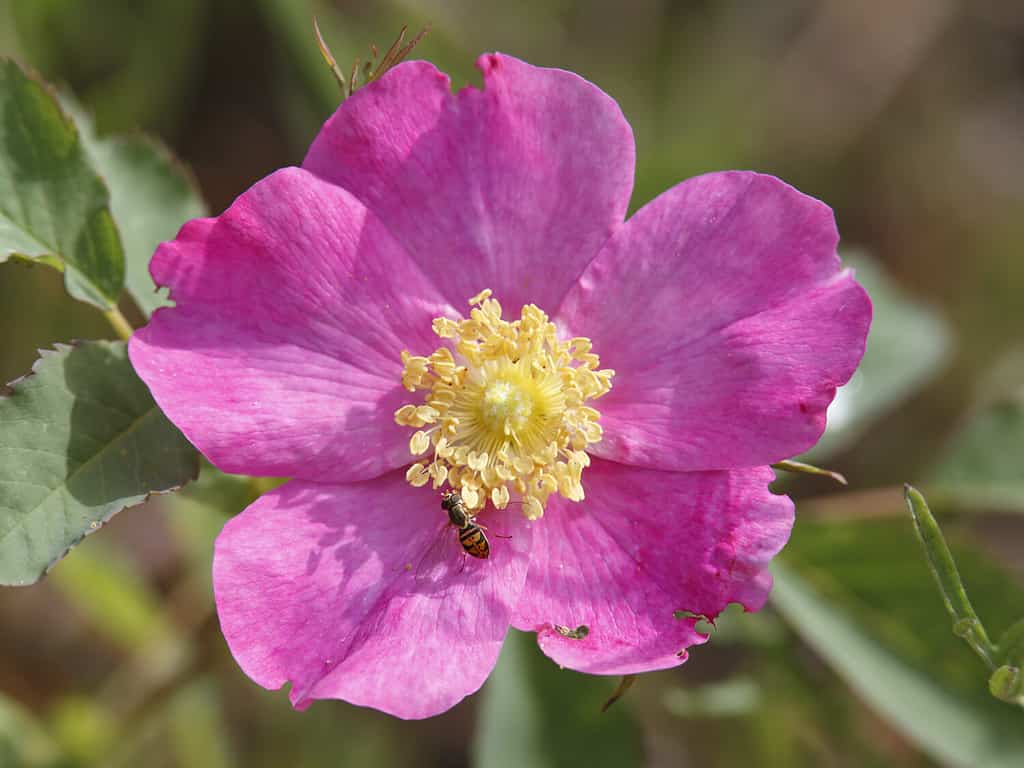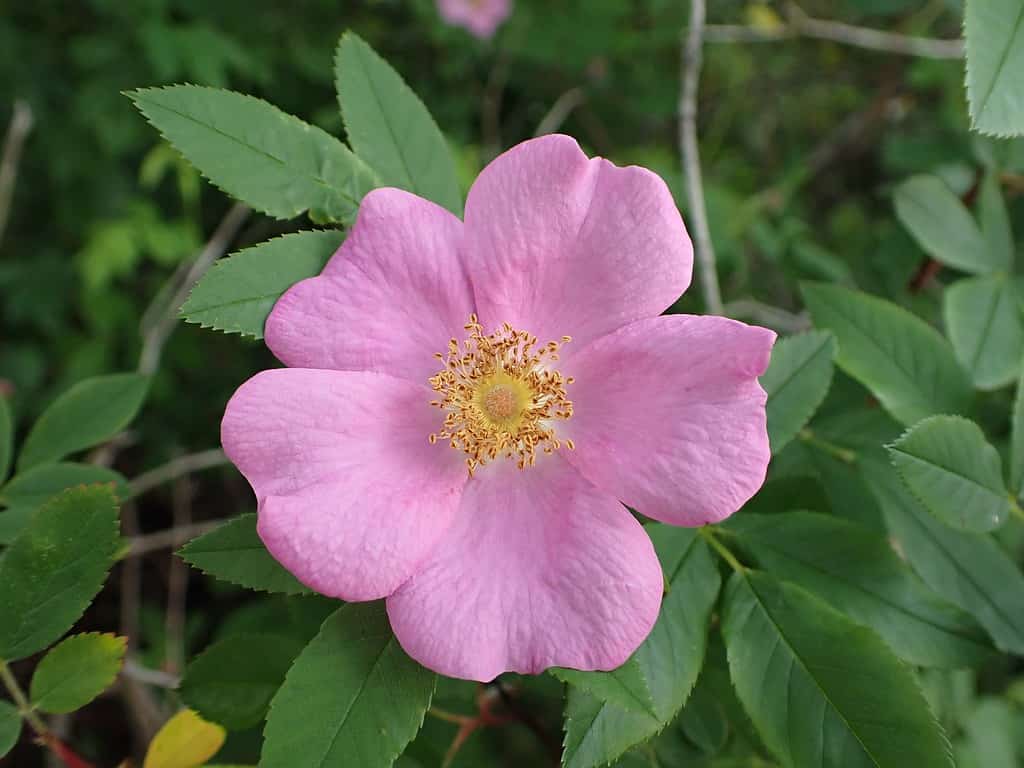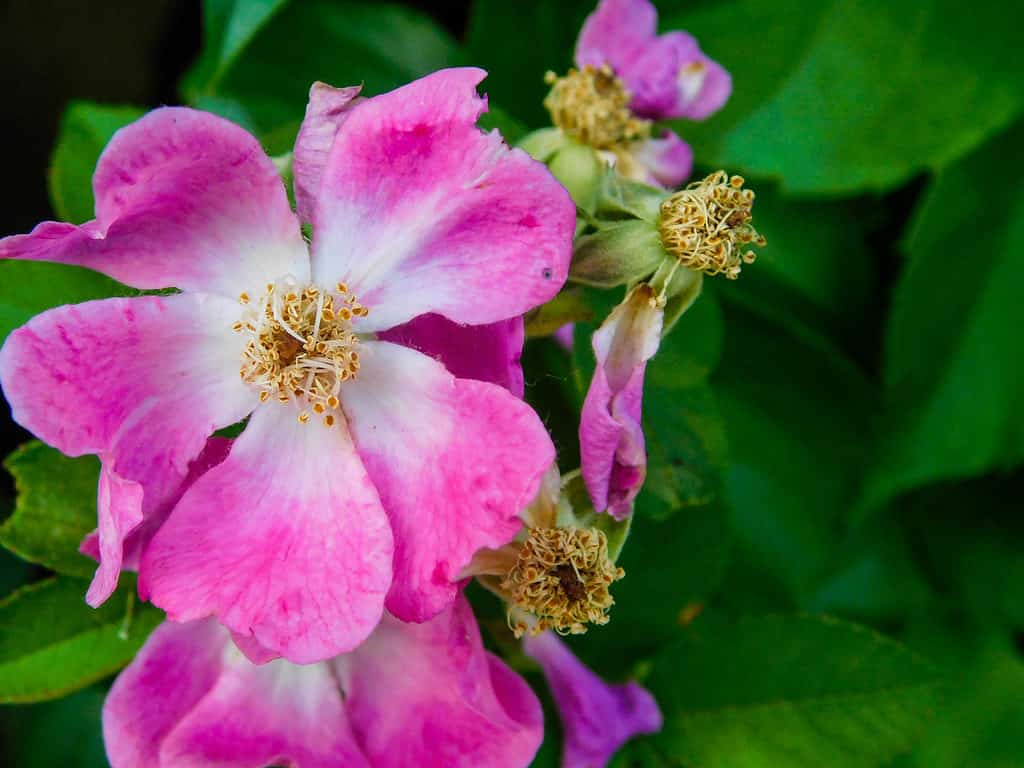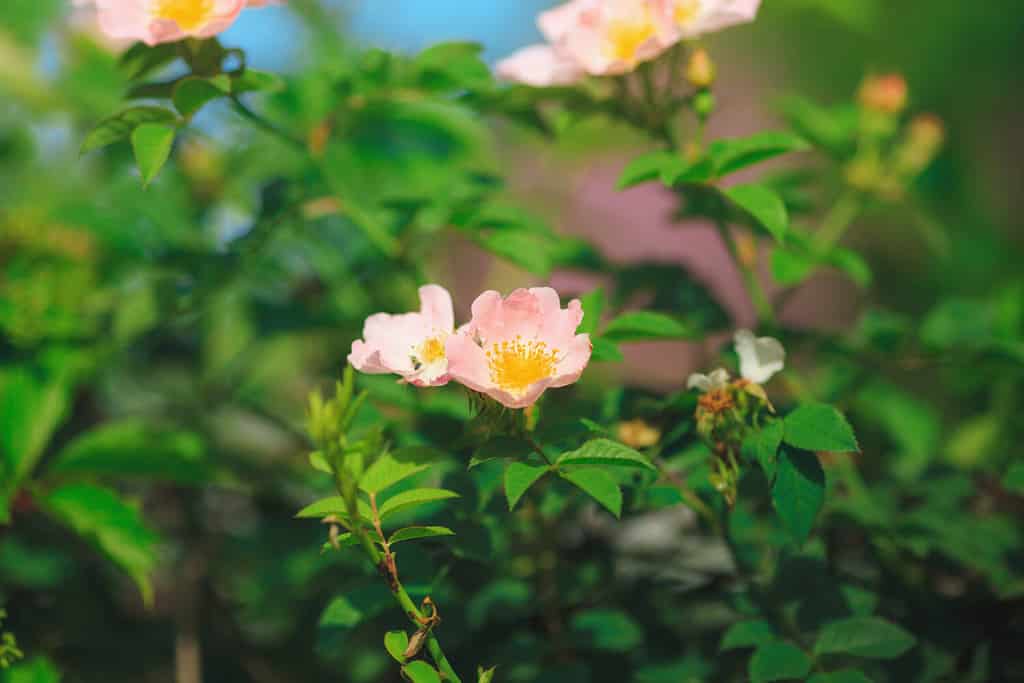In the heart of Ohio, a delicate symphony of nature unfolds. Orchestrated by the enchanting presence of wild roses, their petals, like silken whispers from the heavens, unfurl in a pink pastel parade. Their sweet fragrance sweeps along on the gentle breeze that ripples through the countryside. A beguiling and fragrant tapestry, woven with the intoxicating perfume of these ephemeral beauties. These resplendent wild roses grace Ohio with their enchanting presence, a testament to the exquisite elegance found within the heartland’s embrace. Join us as we discover 5 wild roses that grow in Ohio and how to tell them apart.
Discover 5 Wild Roses That Grow In Ohio: Meadow Rose
Rosa blanda, commonly known as the meadow rose or smooth rose, is a charming species of wild rose that is native to Ohio. This delightful rose species thrives in a variety of habitats. These include meadows, prairies, and open woodlands. Meadow roses add a touch of elegance and natural beauty to the landscape. Rosa blanda is a deciduous shrub that grows to a height of 3-5 feet (1-1.5 m). It spreads out with arching branches. Unlike some other wild rose species, it has relatively few thorns, making it easier to handle and cultivate. The leaves are compound, consisting of several oval-shaped leaflets that have serrated edges, creating a lush backdrop for the blossoms.
Meadow Rose: Appearance
The flowers of the meadow rose are a true delight to behold. Blooming in late spring to early summer, they exhibit a soft, delicate beauty that enchants onlookers. The single flowers feature five rounded petals in shades ranging from pale pink to deep rose. The blooms’ subtle fragrance adds to their allure. These blossoms are a magnet for pollinators, such as bees and butterflies. These insects play a crucial role in the plant’s reproduction. Rosa blanda is its adaptability to a range of soil conditions, including sandy, loamy, or clay soils. This adaptability makes it a versatile and resilient species that can thrive in different environments. It is often found in meadows or open areas where it receives ample sunlight.
In addition to its aesthetic appeal, Rosa blanda provides important ecological benefits. The dense shrubbery offers shelter and nesting sites for birds and small mammals. The plant’s fruits, rose hips, are rich in vitamin C and serve as a food source for wildlife. The rose hips also persist through the winter, providing a source of food when other resources may be scarce. Rosa blanda is not only a cherished wildflower but also a suitable choice for landscaping and garden settings. Its attractive flowers, adaptability, and low-maintenance nature make it a popular choice for native pollinator gardens or adding a touch of native beauty to landscapes.

The single flowers of
Rosa blandafeature five rounded petals in shades ranging from pale pink to deep rose, with a subtle fragrance that adds to their allure.
©Brian Lasenby/Shutterstock.com
Swamp Rose
Rosa palustris, commonly known as the swamp rose or marsh rose, is a captivating species of wild rose that thrives in wetland habitats across North America, including Ohio. This beautiful rose species is well-adapted to marshy areas, where it adds a touch of elegance to the otherwise rugged terrain.
Rosa palustris is a deciduous shrub that typically grows to a height of 3-6 feet (1-2 m). Its stems are armed with sharp thorns, serving as a protective barrier for the plant. The leaves are pinnately compound, consisting of several toothed leaflets that provide a vibrant green backdrop to the blossoms.
The flowers of Rosa palustris bloom in late spring to early summer. The single flowers bear five rounded, pink petals surrounding a prominent cluster of bright yellow stamens. The blossoms are an invitation to pollinators like bees and butterflies, ensuring the continuation of this species through their diligent work.
Meadow Roae: Soil
Rosa palustris is able to tolerate and even thrive in wet, acidic soils found in swampy or marshy environments. This adaptability makes it a valuable component of wetland ecosystems, where it provides both beauty and ecological services. The dense shrubbery of Rosa palustris offers shelter and nesting sites for birds, while its fruits, called rose hips, serve as a food source for various wildlife, including birds and small mammals. Moreover, the root system of this species helps stabilize soil and prevent erosion in wetland areas. While Rosa palustris is well-suited to its natural wetland habitats, it can also be cultivated in gardens and landscapes, adding a touch of wild beauty to more controlled settings. Its attractive flowers, coupled with its ability to withstand damp conditions, make it a desirable choice for areas with poor drainage.

, commonly known as the swamp rose or marsh rose, is a captivating species of wild rose.
©Dan4Earth/Shutterstock.com
Discover 5 Wild Roses That Grow In Ohio: Pasture Rose
Rosa carolina, commonly known as the Carolina rose, or the pasture rose, is a charming and resilient species of wild rose native to Ohio. This beautiful rose species thrives in various habitats, including open woodlands, meadows, and along roadsides, where it adds a touch of elegance and natural grace to the landscape.
Rosa Carolina: Appearance
Rosa carolina is a deciduous shrub that typically grows to a height of 2-4 feet (0.6-1.2 m). It has slender, arching branches adorned with sharp thorns, serving as a defense mechanism against browsing animals. The leaves are pinnately compound, consisting of several oval-shaped, toothed leaflets that provide an attractive backdrop to the blossoms. The flowers of Rosa carolina bloom in late spring to early summer. They present with a delicate beauty that captures the essence of the wild. The single flowers feature five rounded, pale pink petals, sometimes with a hint of white, surrounding a center of bright yellow stamens.
While they may not possess a strong fragrance, their dainty charm makes them a captivating sight. These blossoms attract various pollinators, including bees and butterflies, which play a crucial role in the plant’s reproduction. Rosa carolina also provides shelter and nesting sites for birds and small mammals. The plant’s fruits, called rose hips, are rich in vitamins and provide a valuable food source for wildlife, particularly during the winter months when other food options may be scarce. Rosa carolina is not only appreciated in its natural habitat but can also be cultivated in gardens and landscapes. Its attractive flowers, adaptability, and low-maintenance nature make it a desirable choice for creating naturalistic gardens or incorporating native plants into landscaping designs.

©Brookgardener/Shutterstock.com
Climbing Rose
Rosa setigera, the climbing rose, is a captivating wild rose species that adds a touch of elegance and natural beauty to the landscapes of Ohio. This vigorous climbing rose is known for its ability to gracefully ascend fences, trellises, and arbors, creating a stunning visual display.
Rosa setigera is a deciduous shrub that can grow to impressive heights, reaching up to 15 feet (4.5 m) when given suitable support. Its long, arching canes are armed with sharp thorns, aiding in its ability to climb and providing protection from browsing animals. The leaves are pinnately compound, consisting of several oval-shaped leaflets with serrated edges, creating an attractive backdrop for the blossoms.
The flowers of Rosa setigera are a true spectacle. Blooming in late spring to early summer, they showcase a profusion of delicate pink blossoms that are arranged in loose clusters. Each flower features five rounded petals surrounding a center of bright yellow stamens. While individually small, the abundance of blossoms creates a breathtaking display, which is further accentuated by their subtly sweet fragrance. These flowers are not only aesthetically pleasing but also attract pollinators such as bees and butterflies.
Climbing Rose: Growing Conditions
Rosa setigera is adaptable to a wide range of growing conditions. It thrives in full sun to partial shade and can tolerate various soil types, including clay, loam, and sandy soils. This versatility allows it to grow in a variety of habitats, including woodland edges, thickets, and along roadsides. In addition to its climbing abilities and beautiful flowers, Rosa setigera provides ecological benefits. Its dense foliage offers shelter and nesting sites for birds and small mammals. The plant’s fruits, known as rose hips, are rich in vitamins and provide a valuable food source for wildlife. These rose hips persist through the winter, ensuring a vital food supply during colder months.
Rosa setigera can be a stunning addition to gardens and landscapes, particularly when allowed to climb and intertwine with supports. Its ability to cover structures with its cascading canes and produce an abundance of blossoms makes it a popular choice among Ohio’s gardeners.

Each flower of
Rosa setigerafeatures five rounded petals surrounding a center of bright yellow stamens.
©iStock.com/Wirestock
Discover 5 Wild Roses That Grow In Ohio: Prairie Rose
Rosa arkansana, commonly known as the prairie rose, is a native wild rose species that can be found in various regions of Ohio. This resilient and adaptable shrub is well-suited to prairie habitats, and its delicate beauty adds a touch of charm to the natural landscape.
Rosa arkansana is a deciduous shrub that typically reaches a height of 2-5 feet (0.6-1.5 m). It has an upright and spreading growth habit, with branches covered in sharp thorns. The leaves are pinnately compound, consisting of several leaflets with serrated edges, providing an attractive backdrop for the vibrant blossoms.
Prairie Rose: Blooming Habits
The flowers of Rosa arkansana are a true delight. Blooming in late spring to early summer, they display a range of colors, including shades of pink, rose, and sometimes white. The single flowers feature five rounded petals surrounding a center of bright yellow stamens. These blossoms not only provide visual appeal but also emit a subtle, sweet fragrance that adds to their allure. They are pollinated by various insects, including bees and butterflies, which aid in the plant’s reproduction. Rosa arkansana will tolerate different soil types and growing conditions. It is typically found in prairie habitats, where it thrives in full sun and well-drained soils. However, it can also tolerate drier conditions and sandy soil.
Rosa arkansana provides shelter and nesting sites for birds and small mammals. Its fruits, known as rose hips, are rich in vitamins and serve as a valuable food source for wildlife, particularly during the winter months when other food options may be limited. Rosa arkansana has been used by Native American tribes for various purposes. The rose hips were consumed for their nutritional value, and the plant had medicinal uses for treating ailments such as colds and sore throats. The prairie rose holds a place in the folklore and traditions of many indigenous communities.

The flowers of
Rosa arkansanaare a true delight, displaying a range of colors, including shades of pink, rose, and sometimes white.
©Batechenkofff/Shutterstock.com
The photo featured at the top of this post is © Photoglitz/Shutterstock.com
Thank you for reading! Have some feedback for us? Contact the AZ Animals editorial team.






